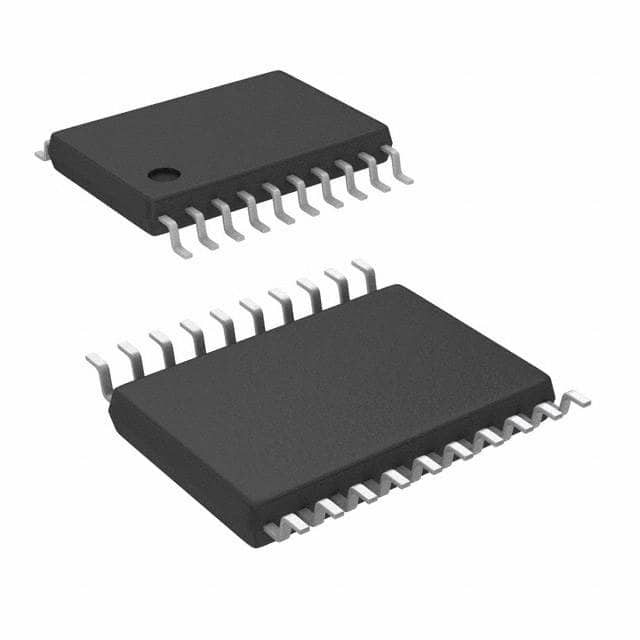Xem thông số kỹ thuật để biết chi tiết sản phẩm.

74LVX245TTR
Product Overview
- Category: Integrated Circuit (IC)
- Use: Level Shifter/Transceiver
- Characteristics: High-speed, low-power, bidirectional voltage level translation
- Package: TSSOP (Thin Shrink Small Outline Package)
- Essence: The 74LVX245TTR is a level shifter/transceiver IC that allows bidirectional voltage level translation between different logic levels. It is commonly used in digital systems where interfacing between devices operating at different voltage levels is required.
- Packaging/Quantity: The 74LVX245TTR is typically available in reels containing 2,500 units.
Specifications
- Supply Voltage: 1.65V to 5.5V
- Logic Family: LVX
- Number of Channels: 8
- Input/Output Compatibility: TTL/CMOS
- Propagation Delay: 4.3 ns (typical)
- Operating Temperature Range: -40°C to +85°C
Detailed Pin Configuration
The 74LVX245TTR has a total of 20 pins, which are assigned as follows:
- Pins 1-8: Channel A (Bidirectional Data Bus)
- Pins 9-16: Channel B (Bidirectional Data Bus)
- Pin 17: Output Enable (Active Low)
- Pin 18: Direction Control (Input)
- Pin 19: GND (Ground)
- Pin 20: VCC (Power Supply)
Functional Features
- Bidirectional voltage level translation between two logic levels
- High-speed operation with minimal propagation delay
- Low power consumption
- TTL and CMOS compatible inputs and outputs
- Output enable control for tri-state output capability
- Direction control for selecting data flow direction
Advantages and Disadvantages
Advantages: - Enables interfacing between devices operating at different voltage levels - High-speed operation allows for efficient data transfer - Low power consumption helps in reducing overall system power requirements - Tri-state output capability provides flexibility in bus sharing scenarios
Disadvantages: - Limited to bidirectional level shifting/transceiving, not suitable for unidirectional applications - Requires careful consideration of voltage compatibility and signal integrity when used in mixed-voltage systems
Working Principles
The 74LVX245TTR operates by utilizing a combination of MOSFETs and CMOS logic to achieve bidirectional voltage level translation. The direction control pin determines the flow of data, while the output enable pin allows for tri-state output when disabled.
Detailed Application Field Plans
The 74LVX245TTR finds applications in various digital systems where interfacing between devices operating at different voltage levels is required. Some common application fields include:
- Microcontroller interfacing with peripheral devices
- Communication interfaces (e.g., UART, SPI, I2C) between devices operating at different voltage levels
- Level shifting in battery-powered portable devices
- Mixed-voltage system integration in automotive electronics
- Industrial automation systems requiring voltage level translation
Detailed and Complete Alternative Models
- 74LVC245A: Similar functionality with improved voltage tolerance and lower power consumption
- SN74LV1T34: Unidirectional level shifter with single-channel functionality
- CD4504B: Hex non-inverting level shifter with additional buffering capabilities
These alternative models offer similar or enhanced features compared to the 74LVX245TTR and can be considered based on specific application requirements.
Word count: 413 words
Liệt kê 10 câu hỏi và câu trả lời thường gặp liên quan đến ứng dụng 74LVX245TTR trong giải pháp kỹ thuật
Sure! Here are 10 common questions and answers related to the application of 74LVX245TTR in technical solutions:
Q: What is the 74LVX245TTR? A: The 74LVX245TTR is a bidirectional octal bus transceiver with 3-state outputs, commonly used for level shifting and signal buffering.
Q: What is the voltage range supported by the 74LVX245TTR? A: The 74LVX245TTR supports a voltage range of 2V to 5.5V, making it compatible with various logic families.
Q: How many channels does the 74LVX245TTR have? A: The 74LVX245TTR has 8 bidirectional channels, allowing for simultaneous data transfer in both directions.
Q: Can the 74LVX245TTR handle high-speed data transmission? A: Yes, the 74LVX245TTR is designed to support high-speed data transmission up to 100MHz, making it suitable for many applications.
Q: What is the maximum current that can be sourced or sunk by each channel? A: Each channel of the 74LVX245TTR can source or sink up to 24mA of current, providing sufficient drive capability for most loads.
Q: Is the 74LVX245TTR compatible with TTL and CMOS logic levels? A: Yes, the 74LVX245TTR is compatible with both TTL and CMOS logic levels, allowing for easy integration into existing systems.
Q: Can the 74LVX245TTR be used as a level shifter between different voltage domains? A: Yes, the 74LVX245TTR can be used as a bidirectional level shifter, enabling communication between devices operating at different voltage levels.
Q: Does the 74LVX245TTR have built-in protection against overvoltage or ESD events? A: Yes, the 74LVX245TTR incorporates protection diodes to safeguard against overvoltage and electrostatic discharge (ESD) events.
Q: Can the 74LVX245TTR be used in bus arbitration applications? A: Yes, the 74LVX245TTR is commonly used in bus arbitration scenarios where multiple devices need to share a common bus.
Q: Are there any specific layout considerations when using the 74LVX245TTR? A: Yes, it is recommended to follow proper PCB layout guidelines, such as minimizing trace lengths and providing adequate decoupling capacitors, to ensure optimal performance of the 74LVX245TTR.
Please note that these answers are general and may vary depending on the specific application and requirements.

